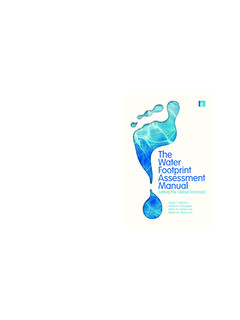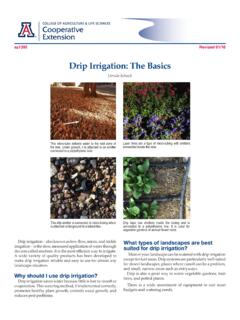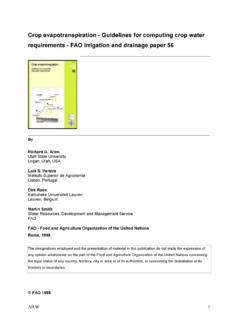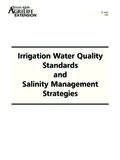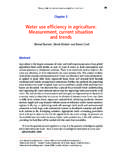Transcription of Water footprints of nations: Water use by people as a ...
1 Water Resour Manage (2007) 21:35 48 DOI ARTICLEW ater footprints of nations: Water use by people as afunction of their consumption patternA. Y. Hoekstra A. K. ChapagainReceived: 18 January 2005 / Accepted: 12 October 2005C Springer Science+Business Media 2006 AbstractThe Water footprint shows the extent of Water use in relation to consumptionof people . The Water footprint of a country is defined as the volume of Water needed forthe production of the goods and services consumed by the inhabitants of the country. Theinternal Water footprint is the volume of Water used from domestic Water resources; theexternal Water footprint is the volume of Water used in other countries to produce goods andservices imported and consumed by the inhabitants of the country.
2 The study calculates thewater footprint for each nation of the world for the period 1997 2001. The USA appears tohave an average Water footprint of 2480 m3/cap/yr, while China has an average footprint of700 m3/cap/yr. The global average Water footprint is 1240 m3/cap/yr. The four major directfactors determining the Water footprint of a country are: volume of consumption (related tothe gross national income); consumption pattern ( high versus low meat consumption);climate (growth conditions); and agricultural practice ( Water use efficiency).KeywordsWater Water dependencyIntroductionDatabases on Water use traditionally show three columns of Water use: Water withdrawalsin the domestic, agricultural and industrial sector respectively (Gleick, 1993; Shiklomanov,2000; FAO, 2003).
3 A Water expert being asked to assess the Water demand in a particularcountry will generally add the Water withdrawals for the different sectors of the useful information, this does not tell much about the Water actually needed by thepeople in the country in relation to their consumption pattern. The fact is that many goodsA. Y. Hoekstra ( )University of Twente, Enschede, The Netherlandse-mail: K. ChapagainUNESCO-IHE, Delft, The NetherlandsSpringer36 Water Resour Manage (2007) 21:35 48consumed by the inhabitants of a country are produced in other countries, which means that itcan happen that the real Water demand of a population is much higher than the national waterwithdrawals do suggest.
4 The reverse can be the case as well: national Water withdrawalsare substantial, but a large amount of the products are being exported for 2002, the Water footprint concept was introduced in order to have a consumption-based indicator of Water use that could provide useful information in addition to the tra-ditional production-sector-based indicators of Water use (Hoekstra and Hung, 2002). Thewater footprint of a nation is defined as the total volume of freshwater that is used to pro-duce the goods and services consumed by the people of the nation. Since not all goodsconsumed in one particular country are produced in that country, the Water footprint consistsof two parts: use of domestic Water resources and use of Water outside the borders of Water footprint has been developed in analogy to the ecological footprint conceptas was introduced in the 1990s (Rees, 1992; Wackernagel and Rees, 1996; Wackernagelet al.)
5 , 1997). The ecological footprint of a population represents the area of productiveland and aquatic ecosystems required to produce the resources used, and to assimilate thewastes produced, by a certain population at a specified material standard of living, whereveron earth that land may be located. Whereas the ecological footprint thus quantifies theareaneeded to sustain people s living, the Water footprint indicates thewaterrequired to sustaina Water footprint concept is closely linked to the virtual Water concept. Virtual wateris defined as the volume of Water required to produce a commodity or service. The conceptwas introduced by Allan in the early 1990s (Allan, 1993, 1994) when studying the optionof importing virtual Water (as opposed to real Water ) as a partial solution to problems ofwater scarcity in the Middle East.
6 Allan elaborated on the idea of using virtual Water import(coming along with food imports) as a tool to release the pressure on the scarcely availabledomestic Water resources. Virtual Water import thus becomes an alternative Water source,next to endogenous Water sources. Imported virtual Water has therefore also been called exogenous Water (Haddadin, 2003).When assessing the Water footprint of a nation, it is essential to quantify the flows of virtualwater leaving and entering the country. If one takes the use of domestic Water resources asa starting point for the assessment of a nation s Water footprint, one should subtract thevirtual Water flows that leave the country and add the virtual Water flows that enter objective of this study is to assess and analyse the Water footprints of nations.
7 The studybuilds on two earlier studies. Hoekstra and Hung (2002, 2005) have quantified the virtualwater flows related to the international trade of crop products. Chapagain and Hoekstra (2003)have done a similar study for livestock and livestock products. The concerned time period inthese two studies is 1995 1999. The present study takes the period of 1997 2001 and refinesthe earlier studies by making a number of improvements and nation s Water footprint has two components, the internal and the external Water internal Water footprint (IWFP) is defined as the use of domestic Water resources toproduce goods and services consumed by inhabitants of the country.
8 It is the sum of the totalwater volume used from the domestic Water resources in the national economyminustheSpringerWater Resour Manage (2007) 21:35 4837volume of virtual Water export to other countries insofar related to export of domesticallyproduced products:IWFP=AWU+IWW+DW W VWEdom(1)Here,AW Uis the agricultural Water use, taken equal to the evaporative Water demand ofthe crops;IWWandDWWare the Water withdrawals in the industrial and domestic sectorsrespectively; andVWEdomis the virtual Water export to other countries insofar related toexport of domestically produced products. The agricultural Water use includes both effectiverainfall (the portion of the total precipitation which is retained by the soil and used for cropproduction) and the part of irrigation Water used effectively for crop production.
9 Here we donot include irrigation losses in the term of agricultural Water use assuming that they largelyreturn to the resource base and thus can be external Water footprint of a country (EWFP) is defined as the annual volume of waterresources used in other countries to produce goods and services consumed by the inhabitantsof the country concerned. It is equal to the so-called virtual Water import into the countryminusthe volume of virtual Water exported to other countries as a result of re-export ofimported FP=VWI VWEre export(2)Both the internal and the external Water footprint include the use ofblue Water (ground andsurface Water ) and the use ofgreen Water (moisture stored in soil strata).
10 The use of domestic Water resources comprises Water use in the agricultural, industrial anddomestic sectors. For the latter two sectors we have used data from AQUASTAT (FAO, 2003).Though significant fractions of domestic and industrial Water withdrawals do not evaporatebut return to either the groundwater or surface Water system, these return flows are generallypolluted, so that they have been included in the Water footprint calculations. The total volumeof Water use in the agricultural sector has been calculated in this study based on the totalvolume of crop produced and its corresponding virtual Water content. For the calculation ofthe virtual Water content of crop and livestock products we have used the methodology asdescribed in Chapagain and Hoekstra (2004).





